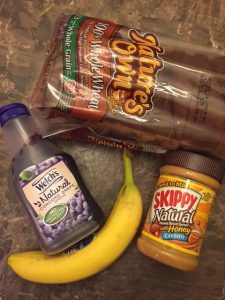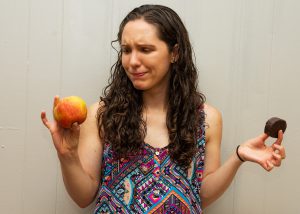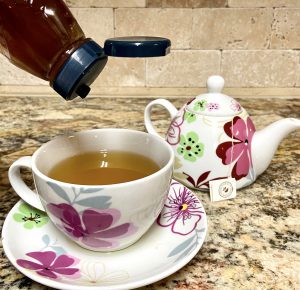
by Amy Mullins | Nov 23, 2021
 Take care of your bones today for better quality of life tomorrow!
Take care of your bones today for better quality of life tomorrow!
According to the National Institutes of Health, about one in every two Americans over the age of 50 may already have or be at risk of developing osteoporosis. (1) Osteoporosis is a disease where, over time, bone quality and strength decline, making bones more likely to fracture and break. Fractures can develop not only as a result of a slip or fall but also from everyday sneezing or coughing. If your doctor diagnoses you with osteoporosis, the best course of action for slowing its progression may be prescription medication. However, nutrition and exercise can help provide a good foundation to prevent or delay disease development. (1)
Know Your Risks
While all risks are not completely understood, there is a genetic factor linked to osteoporosis – mainly, if poor bone mineral density runs in the family. In addition to genetic factors, poor nutrition, smoking, excessive alcohol, and a lack of exercise can all increase your risk of developing osteoporosis. It is important to talk to your doctor to discuss your level of risk and prevention measures. (1)
Build More Bone
Although they may not seem like it, bones are a living tissue and go through times of building and breakdown during the life cycle. Bones grow the most during childhood, but they also change and become stronger as an adult by doing exercises like weightlifting or running. (1) Similar to a savings account or retirement fund, the more you build when you are young, the more you can afford to spend as you age. Current recommendations to support strong bones include muscle strengthening exercises at least two times per week. These exercises require your muscles to do more work than doing just day-to-day activities. Additionally, strength training exercises should be done to the point where it would be difficult to perform one or two more repetitions. Examples include lifting weights, working with resistance bands, and doing body weight exercises such as push-ups, pull-ups, and planks. Additionally, climbing stairs, and carrying heavy loads (such as groceries and heavy gardening) also count when done frequently.(2)
Support Your Bones
In addition to exercise, nutrition plays a large role in promoting healthy bones. The two most important nutrients for bone health are calcium and vitamin D. Calcium is what gives bones their strength but is also involved in many other processes in the body. If you do not regularly consume enough calcium, your body takes it from your bones. (3) If this happens for long enough, your bones will become weakened and begin to develop osteoporosis. Vitamin D is important for the absorption of calcium. Not having enough vitamin D can impact your bones, even if you get enough calcium from your diet. (4)
| Life-stage group |
Calcium (mg/day) |
Vitamin D (IU/day) |
| Infants 0-6 months |
200 |
400 |
| Infants 6-12 months |
260 |
400 |
| 1-3 years old |
700 |
600 |
| 4-8 years old |
1,000 |
600 |
| 9-13 years old |
1,300 |
600 |
| 14-18 years old |
1,300 |
600 |
| 19-30 years old |
1,000 |
600 |
| 31-50 years old |
1,000 |
600 |
| 51–70-year-old males |
1,000 |
600 |
| 51–70-year-old females |
1,200 |
600 |
| > 70 years old |
1,200 |
600 |
| 14-18 years old, pregnant/lactating |
1,300 |
600 |
| 19-50 years old, pregnant/lactating |
1,000 |
600 |
Recommended Calcium and Vitamin D Intakes (5) Definitions: mg = milligrams; IU = International Units
Bone Strengthening Foods
There are a variety of food sources that provide calcium and vitamin D. Calcium can be found in dairy products, green vegetables, and calcium-fortified foods. Examples of calcium-containing dairy products include cheese, yogurt, and reduced-fat milk. Other calcium-fortified foods include breads, orange juice, cereals, and tofu. When it comes to vitamin D in your diet, be sure to include fatty fish such as tuna and salmon. There are smaller amounts of vitamin D found in cheese, mushrooms, and beef liver. Similar to calcium, there are many vitamin D-fortified foods available. Some examples are cereals, orange juice, milk, and milk products. Check out the two tables below for calcium and vitamin D food sources. (5)
Calcium Content of Selected Foods
| Food |
Serving size |
Milligram (mg) per serving |
% DV |
| Sardines, canned in oil |
3 oz |
324 |
32% |
| Cheddar cheese, shredded |
1 ½ oz |
306 |
31% |
| Nonfat milk |
8 oz |
302 |
30% |
| Yogurt, reduced fat, no solids |
8 oz |
300 |
30% |
| 2% milk (reduced fat) |
8 fl oz |
297 |
30% |
| Whole milk |
8 fl oz |
291 |
29% |
| Cottage cheese, 1% milk fat |
2 cups, unpacked |
276 |
28% |
| Mozzarella, part skim |
1 ½ oz |
275 |
28% |
| Tofu firm, with calcium |
½ cup |
204 |
20% |
| Orange juice, calcium fortified |
6 fl oz |
200-260 |
20-26% |
| Tofu soft, with calcium |
½ cup |
138 |
14% |
| Frozen yogurt, vanilla, soft serve |
½ cup |
103 |
10% |
| Ready-to-eat cereal, calcium fortified |
1 cup |
100-1000 |
10-100% |
| Turnip greens, boiled |
½ cup |
99 |
10% |
| Kale, raw |
1 cup |
90 |
9% |
| Vanilla ice cream |
½ cup |
85 |
8.5% |
| Soy beverage, calcium fortified |
8 fl oz |
80-500 |
8-50% |
| Flour tortilla |
1, 6” diameter |
37 |
4% |
| Sour cream, reduced fat, cultured |
2 Tbsp |
32 |
3% |
Adapted from Office of the Surgeon General (US). Bone Health and Osteoporosis: A Report of the Surgeon General. (7)
Vitamin D Content of Selected Foods
| Food |
Serving size |
Micrograms (mcg) per serving |
International Units (IU) per serving |
Percent DV |
| Cod liver oil |
1 Tbsp |
34 |
1,360 |
170 |
| Rainbow trout, cooked |
3 oz |
16.2 |
645 |
81 |
| Salmon (sockeye), cooked |
3 oz |
14.2 |
570 |
71 |
| White mushrooms, raw, exposed to UV light |
½ cup |
9.2 |
366 |
46 |
| 2% milk, vitamin D fortified |
1 cup |
2.9 |
120 |
15 |
| Soy, almond, & oat milk, vitamin D fortified |
1 cup |
2.5-3.6 |
100-144 |
13-18 |
| Ready-to-eat cereal, fortified with 10% DV vitamin D |
1 serving |
2.0 |
80 |
10 |
| Sardines (Atlantic), canned in oil, drained |
2 |
1.2 |
46 |
6 |
| Egg, scrambled |
1 large |
1.1 |
44 |
6 |
| Beef liver, braised |
3 oz |
1.0 |
42 |
5 |
| Tuna fish (light), canned in water, drained |
3 oz |
1.0 |
40 |
5 |
| Cheddar cheese |
1.5 oz |
0.4 |
17 |
2 |
| Portabella mushrooms, raw, diced |
½ cup |
0.1 |
4 |
1 |
| Chicken breast, roasted |
3 oz |
0.1 |
4 |
1 |
| Ground beef, 90% lean, broiled |
3 oz |
0 |
1.7 |
0 |
| Broccoli, raw, chopped |
½ cup |
0 |
0 |
0 |
Adapted from Vitamin D – Fact sheet for health professionals (8)
Stay Safe and Healthy as You Age
Osteoporosis can be a serious and life changing diagnosis. However, adopting healthy habits like limiting smoking and excessive alcohol consumption can decrease your risk. Consuming enough calcium and vitamin D each day and getting regular muscle building exercise at least twice a week can also help protect your bones. Women over the age of 65, or anyone diagnosed as “at risk,” should be regularly screened for osteoporosis by a doctor during their yearly physical health exam. (6,7,8)
Making healthy lifestyle choices from a young age can help prevent or delay osteoporosis, but once you’re diagnosed, the best course of action for slowing its progression may be prescription medication. Consult your doctor before beginning a new exercise program or for interactions with medications.
References
- “Osteoporosis Overview.” National Institutes of Health, U.S. Department of Health and Human Services, https://www.bones.nih.gov/health-info/bone/osteoporosis/overview.
- S. Department of Health and Human Services. Physical Activity Guidelines for Americans, 2nd edition. Washington, DC: U.S. Department of Health and Human Services; 2018.
- “Osteoporosis.” Edited by Susan Randall, Osteoporosis | Office on Women’s Health, National Institute of Arthritis and Musculoskeletal and Skin Diseases, 20 May 2019, https://www.womenshealth.gov/a-z-topics/osteoporosis.
- “Office of Dietary Supplements – Vitamin D.” NIH Office of Dietary Supplements, U.S. Department of Health and Human Services, 22 Mar. 2021, https://ods.od.nih.gov/factsheets/vitaminD-HealthProfessional/
- S. Department of Agriculture and U.S. Department of Health and Human Services. Dietary Guidelines for Americans, 2020-2025. 9th Edition. December 2020. Available at DietaryGuidelines.gov
- Palmer S. Bone Health and Diet. Today’s Dietitian. 2013;15(2):44.
- Office of the Surgeon General (US). Bone health and osteoporosis: A report of the surgeon general. Rockville (MD): Office of the Surgeon General (US); 2004. Table 7-2, Selected Food Sources of Calcium. Available from: https://www.ncbi.nlm.nih.gov/books/NBK45523/table/ch7.t2/
- Vitamin D – Fact sheet for health professionals. NIH Office of Dietary Supplements. https://ods.od.nih.gov/factsheets/VitaminD-HealthProfessional/#h3. Published August 17, 2021. Accessed November 11, 2021.
Guest contributors: Andrew Treble and Lexi Fraino are master’s students and Dietetic Interns from Florida State University’s Department of Nutrition & Integrative Physiology.

by Amy Mullins | Aug 27, 2021

Healthy snacks fuel the athlete! Photo credit: Amy Mullins
When it comes to your kids, you’d do anything to help them succeed… in the classroom, in their relationships, in life. So, why not on the basketball court, soccer field, swimming pool, or whichever sport they’ve fallen in love with? They may have the best equipment, participate in extra training lessons, and put in 110% during every practice and event. But, is this enough? Is there something missing?
It’s no secret that your child is growing. In order to function in their sport, improve performance, and promote recovery, kids need food to help support the increased energy requirements. This ultimately means more planning and more groceries!
Follow these guidelines to fuel your superstar during the week, before the game/event, and after the game/event.
Pre-Game Meal/Snack
Eat a good-sized meal at least three hours before the event. This gives the tummy time to process all the food to prepare it as fuel. Have a light balanced meal with some carbs and fats. These will sustain you throughout your exercise! Carbs and fats are both great fuel sources, and the fats digest slower to help keep you feeling full. Pick foods that digest well to avoid any nausea or upset stomach. Don’t forget to drink some water to start off hydrated!
- Breakfast Ideas: fruit, lightly sautéed potatoes, scrambled eggs, or toast with nut butter or smashed avocado
- Lunch Ideas: turkey or ham sandwich (avoid fatty cheeses and condiments), peanut butter and jelly, fruit, pretzels, or cereal
- Snack 30 minutes before the event: peanut butter crackers, granola bars, fruit snacks, or goldfish crackers
During Practice and Games
For exercise lasting less than an hour, sip on some water to stay hydrated. For exercise lasting longer than an hour, a sports drink like Gatorade or Powerade will help replenish lost carbohydrates and electrolytes. For longer lasting activities or day trips, bring along some easy to eat snacks with lots of carbs, and some fats and proteins. Peanut butter and jelly sandwiches and granola bars are great options!
Post-Game Snack
After exercise, it’s important to recover, refuel, and re-hydrate. Protein will help our muscles recover while carbohydrates will help refuel for the next activity. Drink plenty of fluids to rehydrate! Good choices for quick, easy snacks include chocolate milk, peanut butter crackers, cheese sticks, bananas, apple slices with peanut butter, or smoothies with or without protein.
Dinner Plate After Practice and Games
- Grains/Carbs: Should take up roughly 35% of the plate
- Lean Protein: Should take up roughly 25% of the plate
- Fruits and Veggies: Should take up roughly 40% of the plate
- Hydration: Focus on replenishing lost electrolytes and fluid loss
Components of a well-balanced meal include:
- Meat & poultry – great protein sources for recovery. Pair it with a carb!
- Whole grains, fruit, pasta, rice, potatoes – great carb sources to complement your protein. These will help replace the energy you burned during exercise.
- Water, milk, and fruits will help replenish fluids lost during exercise.
Eating right not only on game day but throughout the week will do wonders for your child’s athletic performance. Not only that, it will set them up to be successful and healthy adults in the future!
Guest contributors: Patrick Burns and E. Jane Watts, Dietetic Interns from Florida State University’s Department of Food, Nutrition, and Exercise Sciences
The use of trade names in this post is solely for the purpose of providing specific information. It is not a guarantee, warranty, or endorsement of the product.
References:
Academy of Nutrition & Dietetics. Ellis, E. (2020). Hydrate Right. https://www.eatright.org/fitness/sports-and-performance/hydrate-right/hydrate-right
American Dietetic Association, Dietitians of Canada, American College of Sports Medicine,
Rodriguez, N. R., Di Marco, N. M., & Langley, S. (2009). American College of Sports Medicine position stand. Nutrition and athletic performance. Medicine and science in sports and exercise, 41(3), 709–731.
https://performancepartner.gatorade.com
https://www.eatright.org/fitness/sports-and-performance/tips-for-athletes/gameday-nutrition-tips-for-young-athletes

by Ginny Hinton | Aug 8, 2021
If you’ve tried to find nutrition information in the midst of the Covid-19 pandemic, you probably got more than you bargained for. Recently, I searched “nutrition and COVID-19” and in less than one second, I got 590,000,000 hits. That’s a lot of information! With so much health and nutrition information available, especially connected with the ongoing pandemic, it can be TOUGH to separate fact from fiction. What makes it even tougher is that everyone seems to be passionately and totally convinced that their information is the right answer. How do you tell the hype from the truth?

Confusing Nutrition Choices
Photo Source: Ginny Hinton
The best way to protect yourself against questionable information and products is to become an informed consumer. That can be challenging as so many of us are becoming more used to getting our information from social media, websites, advertisements, friends and family. While information from those sources can be accurate, very often it is misleading. Use the following tips to evaluate nutrition information:
Know Your Experts:
Have you ever seen nutrition advice from a “nutritionist” or “diet counselor”? Beware, because those terms aren’t regulated, and almost anyone can use them to look like an expert. Registered dietitians (RD) or licensed dietitians (LD) hold specialized degrees and are good sources of solid nutritional information.
Media Sources:
The internet, books, newspapers, and magazines can be good sources of information, if you know where to look. If you’re surfing the net, select websites from credible web addresses like ones ending in .edu (universities or medical schools), .gov (government agencies), or sometimes .org (not-for-profit research and education). If you’re reading an article, always look for the author’s qualifications and membership in a professional nutrition organization. With all media, check the sources they used (If they don’t cite credible sources you can check, that’s a big red flag) and scan to the bottom to make sure they’re not trying to sell a product. If you can buy a “miracle” product, a solution, or a quick fix from them, watch out! Their information may be convincing, but it is likely biased or incomplete. At best, it calls for caution and some deeper research.
The flood of health and nutrition misinformation isn’t going away, but learning to be an informed consumer is a powerful step in learning to protect yourself from being duped.

by Ginny Hinton | Aug 17, 2020

Honey or Sugar
Photo Source: Ginny Hinton
Sugar or honey? The debate rages on, with honey probably edging out sugar in popularity. Many people use local honey because of it’s supposed benefit to allergy sufferers (immunotherapy). Others prefer it because it’s processed less than sugar, or because they simply love the taste.
People have been eating honey – or slathering it on their bodies – for hundreds of years. In ancient times, honey was used as a sweetener, as medicine to heal wounds, to relieve stomach problems, and even to fight bad breath. It has many of the same uses today. Honey contains trace amounts of acids that contribute to its antimicrobial activity, so when used on the skin it really can help heal wounds and reduce scar formation. The antioxidants in honey have been linked to properties that may fight cancer. Honey inhibits inflammation, leading to a protective effect for the heart and the whole cardiovascular system, and it’s a great remedy to help ease a bad cough. Does local honey really relieve allergies? There is some anecdotal (personal) evidence, but the jury is still out on that with no consistent clinical study results.
So, how do honey and sugar compare nutritionally? To start, both are carbohydrates, made up mainly of glucose and fructose. The body breaks them both down quickly and they each cause a spike in energy and blood sugar levels, although honey has a somewhat gentler effect. Honey weighs in with more calories at 68 per tablespoon versus sugar’s 49 calories per tablespoon. To balance out the calorie factor, honey is sweeter than sugar, so you may need to use less of it in your food. Honey may also be easier to digest because bees have already added enzymes that start to break it down. The bottom line is that both sugar and honey are sweeteners, they are nutritionally very similar, and using too much of either can lead to unwanted consequences such as weight gain, risk of illness, and tooth decay. Whether you use sugar or honey, it’s a great idea to limit consumption. The following tips may help, whichever sweetener you decide to use:
* Cut the amount of sweetener you use for drinks or
cooking in half and see if you still like the taste.
* Cut sweetener in baking by 1/3 or substitute mashed
banana for the sweetener.
* Add spices to substitute for some of the sweetener in a
recipe. Examples that add flavor without the calories are
almond, vanilla, and cinnamon.
Whatever tip you use, you’ll be ahead of the game if you can gradually cut the amount of sweetener you use, whether for cooking, baking, or drinking.
For more information about honey, sugar, or general nutrition, contact your local UF/IFAS Extension Agent.

by Terri Keith | Aug 4, 2020

Credit: Photo by JÉSHOOTS from Canva Free Images
Watermelon is a tasty treat so celebrating watermelons in August sounds like a great reason to break out all the delicious and healthy watermelon recipes I’ve been saving—like this one for Watermelon Limeade.
Did you know that eating watermelon provides your body with Vitamins A, B6, C and potassium? Red watermelons are also a good source of lycopene. A two-cup serving of watermelon only has 80 calories but can provide 6% of your daily value of potassium, 8% of Vitamin A, 25% of Vitamin C and more!
Watermelons are also completely edible, from the fleshy center part all the way out to the green rind. The rind is typically cooked or pickled before being eaten and Watermelon Rind Pickles are popular here in the Southeast. Ninety percent of watermelons sold in stores are seedless, but if you do get a seeded watermelon, the seeds can be cooked and eaten too! They are usually sprouted and roasted or dried first.

Photo Credit: UF/IFAS File Photo
Buying a whole watermelon versus one that’s pre-cut can be a better value, but you’ll want to make sure you select a ripe melon. There’s an old wives’ tale about thumping the watermelon but the best way to choose is by picking it up and looking at it. Here’s what you’re checking for:
- Look for a watermelon that doesn’t have any bruises, cuts, or dents. Some scratches are normal.
- Check for a buttery or creamy yellow spot. This is an indicator of where the watermelon rested on the ground while it ripened.
- The watermelon should be heavy considering the size. It is 92% water!
When you are preparing your watermelon, make sure to wash it before cutting into it. Use cool running water, scrub it with a produce brush, then dry it with a clean paper towel or cloth towel. Many people skip this step since it’s heavy and can be bulky but it’s an important part of maintaining your food’s safety. If you don’t wash your watermelon before cutting into it, you could be transferring bacteria from the outside of the melon to the inner flesh. Be sure your hands and any knives, utensils and cutting boards you will be using are clean as well.
An uncut watermelon can be stored outside of the refrigerator for a week if it wasn’t previously chilled. Once it has been cut open, it will need to be stored in an airtight container and refrigerated—you’ll want to enjoy it within a week.
When you think about eating watermelon, I bet the first image that comes to mind is eating a plain slice right from the fruit. And that’s great! Just keep in mind that watermelon can be made into drinks, added to salads, frozen into popsicles, incorporated in a stir-fry or slaw or even grilled!
Now, back to those recipes… here’s one for Watermelon Rind Pickles if you want to enjoy them right away (these will only keep for 2 weeks in the refrigerator) and this is one for canning Watermelon Rind Pickles so you have them year-round! And if you want more, try the recipe section at the Produce for Better Health Foundation or the National Watermelon Promotion Board. Celebrate watermelons this August by trying a new recipe or two with this amazing fruit!
Resources:
National Watermelon Promotion Board. Frequently Asked Questions: https://www.watermelon.org/watermelon-101/facts-faqs/
National Watermelon Promotion Board, Nutrition: https://www.watermelon.org/nutrition/nutrient-profile/
Produce for Better Health Foundation, Top 10 Ways to Enjoy Watermelon: https://fruitsandveggies.org/stories/top-10-ways-enjoy-watermelon/

 Take care of your bones today for better quality of life tomorrow!
Take care of your bones today for better quality of life tomorrow!








